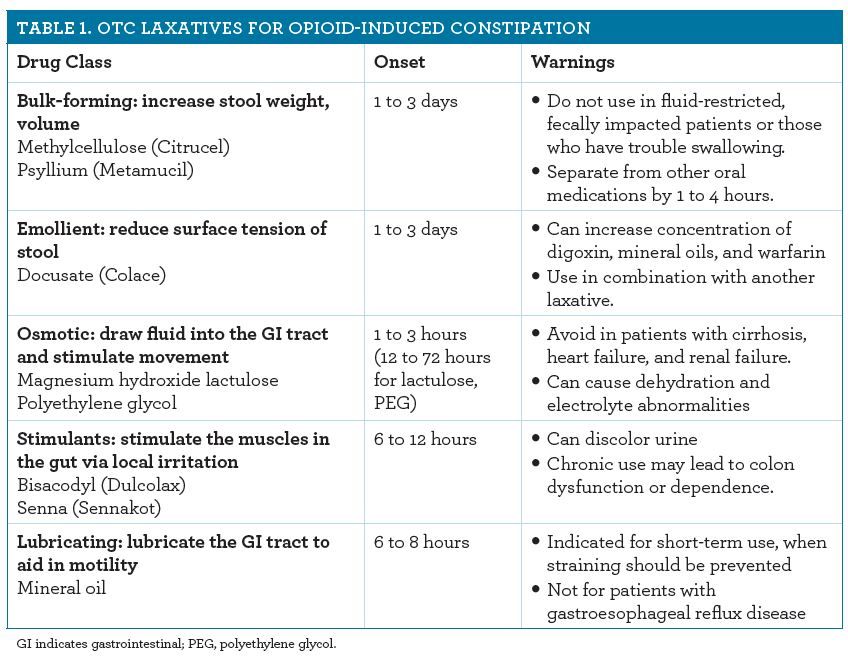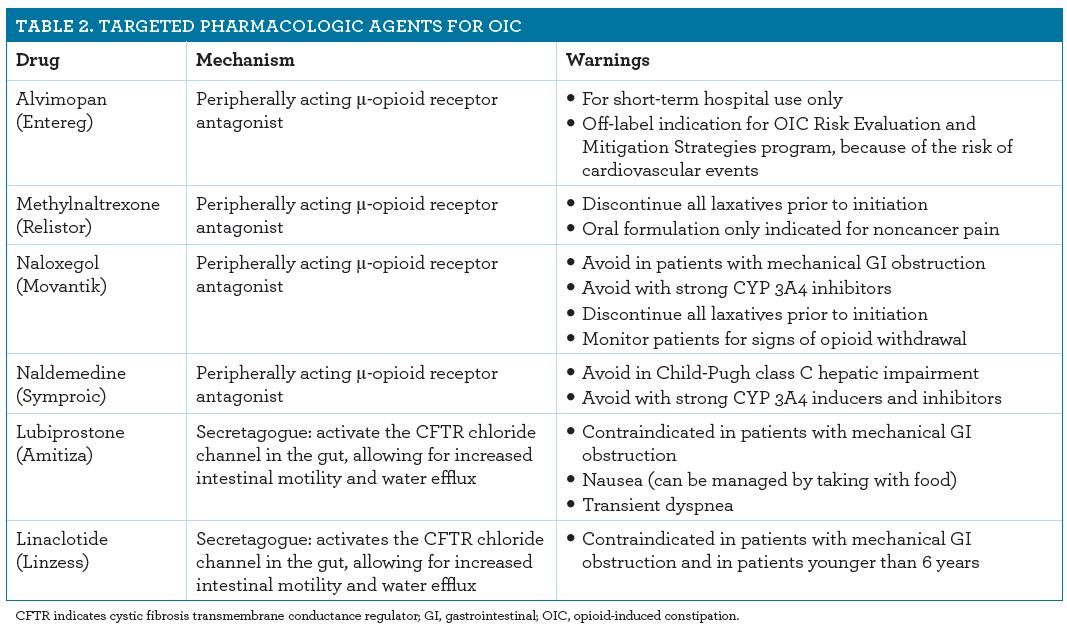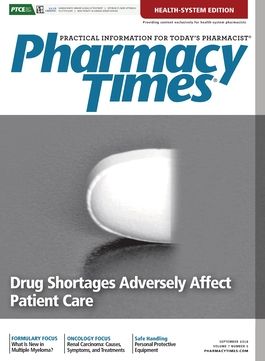Publication
Article
Pharmacy Practice in Focus: Health Systems
Opioid-Induced Constipation
Opioids are associated with various adverse effects, including constipation, nausea, respiratory depression, sedation, and vomiting.
Opioids are associated with various adverse effects (AEs), including constipation, nausea, respiratory depression, sedation, and vomiting.
Gastrointestinal (GI) AEs are most commonly reported with opioid use. However, unlike other GI AEs, which improve over time, opioid-induced constipation (OIC) is persistent.1 Failure to prevent or to adequately treat OIC can lead to treatment dissatisfaction and discontinuation of opioid therapy, a major obstacle to effective management of noncancer chronic pain.
OIC occurs in about 40% to 90% of patients treated for noncancer pain.2 A consensus definition for OIC is a change from baseline in bowel habits and change in defecation patterns after initiating opioids, which is characterized by decreased frequency of bowel movements (BMs), a feeling of incomplete evacuation, harder stool consistency, and worsening of straining to pass BMs.3
OIC is caused by peripheral effects on enteric µ-receptors in the central nervous system. Opioid agonist binding decreases gastric emptying, delays transit throughout the intestines, increases pyloric sphincter tone and resting anal sphincter pressure, and inhibits electrolyte secretion and water into the intestinal lumen.4
Because of the lack of treatment guidelines for OIC, health care providers use agents in varying combinations based on comfort level, common practices at their institutions, or medication availability. It is important to consider both objective measures of stool consistency and frequency and subjective measures of bloating, discomfort/pain, fatigue, and satisfaction when assessing a patient’s severity of constipation.
Treatment of OIC is complex and should be approached in a stepwise fashion, involving dietary modifications, laxative use, and lifestyle changes—although most OTC laxatives do not target the underlying mechanism of OIC. Recently, a new class of peripherally acting µ-opioid receptor antagonists became available to address this gap in therapy. These agents selectively inhibit the action of opioids in the GI tract while preserving centrally mediated analgesia, allowing the preservation of bowel function without compromising adequate pain control.5,6
Clinicians should always ensure that patients first try nonpharmacologic measures to manage their bowel habits. Patients should be eating foods rich in fiber, drinking adequate fluids, and exercising regularly.
Once a clinical diagnosis of OIC occurs, the goals of treatment are to establish regular bowel habits and relieve symptoms while minimizing any AEs. OIC is less likely to respond to dietary changes than other types of constipation. Prophylaxis should be considered for every patient beginning an opioid regimen. Typical prophylaxis for constipation includes a stimulant laxative and stool softener. OTC laxatives (Table 1) are first-line therapy because of their relatively low cost and risk.

Because OTC laxatives do not work to resolve the underlying pathophysiology of OIC, some patients find these agents ineffective. Only after patients have failed to find relief with first-line OTC interventions should newer prescription medications be considered (Table 2). Agents can be classified into 2 major groups: the peripherally acting µ-opioid receptor antagonists (PAMORAs) and the secretagogues. Disadvantages of the PAMORAs include their high cost and the potential for withdrawal-like symptoms. These agents should not be used in patients with bowel obstruction or those who are at an increased risk for obstruction.1,7

A novel agent to prevent OIC is Targiniq, which is a combination of naloxone and oxycodone. This drug carries a black-box warning for potential abuse and misuse. AEs are similar to those of other opioid analgesics, such as hypotension, respiratory depression, and tolerance.8
Pharmacists can play a pivotal role in managing and preventing OIC. They must perform a comprehensive medication review to ensure that patients on opioids for chronic pain are not on other concomitant medication that may cause constipation, such as anticholinergics, antihistamines, nondihydropyridine calcium channel blockers, and tricyclic antidepressants. Additionally, they should counsel patients about the potential for OIC and how to make appropriate lifestyle modifications.
In light of the opioid epidemic, it is critical that pharmacists are proactive about counseling patients on opioid use, AEs, and nonpharmacologic and pharmacologic interventions for managing OIC, a prevalent AE of long-term opioid use, potentially affecting quality of life. Pharmacists should be aware of the various nonpharmacologic and pharmacologic therapies available for managing OIC.
Zahava Picado, PharmD, is a PGY-1 pharmacy resident at Central Texas Veterans Healthcare System in Austin. Deepali Dixit, PharmD, BCPS, BCCCP, is a clinical associate professor at the Ernest Mario School of Pharmacy at Rutgers, the State University of New Jersey, in Piscataway, and a clinical pharmacy specialist, critical care, at Robert Wood Johnson University Hospital in New Brunswick, New Jersey.
References
- Nelson AD, Camilleri M. Opioid-induced constipation: advances and clinical guidance. Ther Adv Chronic Dis. 2016;7(2):121-134. doi: 10.1177/2040622315627801.
- Bell TJ, Panchal SJ, Miaskowski C, Bolge SC, Milanova T, Williamson R. The prevalence, severity, and impact of opioid-induced bowel dysfunction: results of a US and European patient survey (PROBE 1). Pain Med. 2009;10(1):35-42. doi: 10.1111/j.1526-4637.2008.00495.x.
- Gaertner J, Siemens W, Camilleri M, et al. Definitions and outcome measures of clinical trials regarding opioid-induced constipation: a systematic review. J Clin Gastroenterol. 2015;49(1):9-16. doi: 10.1097/MCG.0000000000000246.
- Holzer P. Methylnaltrexone for the management of unwanted peripheral opioid effects. Therapy. 2008;5(4):531-543. openaccessjournals.com/articles/methylnaltrexone-for-the-management-of-unwanted-peripheral-opioid-effects.pdf. Accessed Aug. 1, 2018.
- Argoff CE, Brennan MJ, Camilleri M, et al. Consensus recommendations on initiating prescription therapies for opioid-induced constipation. Pain Med. 2015;16(12):2324-2337. doi: 10.1111/pme.12937.
- Larkin PJ, Sykes NP, Centeno C, et al; European Consensus Group on Constipation in Palliative Care. The management of constipation in palliative care: clinical practice recommendations. Palliat Med. 2008;22(7):796-807. doi: 10.1177/0269216308096908.
- Bharucha AE, Pemberton JH, Locke GR 3rd. American Gastroenterological Association technical review on constipation. Gastroenterology. 2013;144(1):218-238. doi: 10.1053/j.gastro.2012.10.028.
- Targiniq [prescribing information]. Stamford, CT: Purdue Pharma L.P.; 2014. www. accessdata.fda.gov/drugsatfda_docs/label/2014/205777lbl.pdf. Accessed July 30, 2018.







